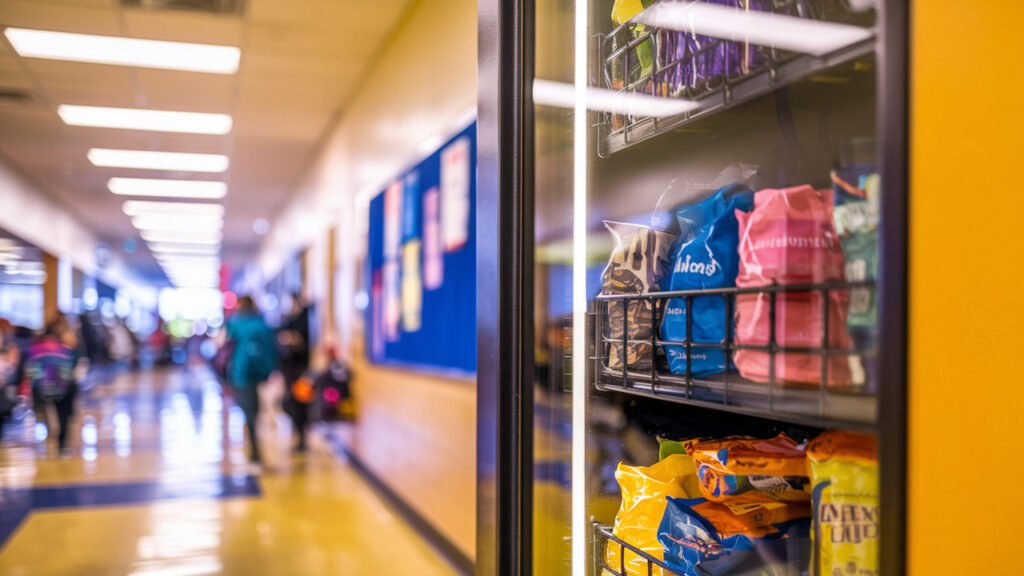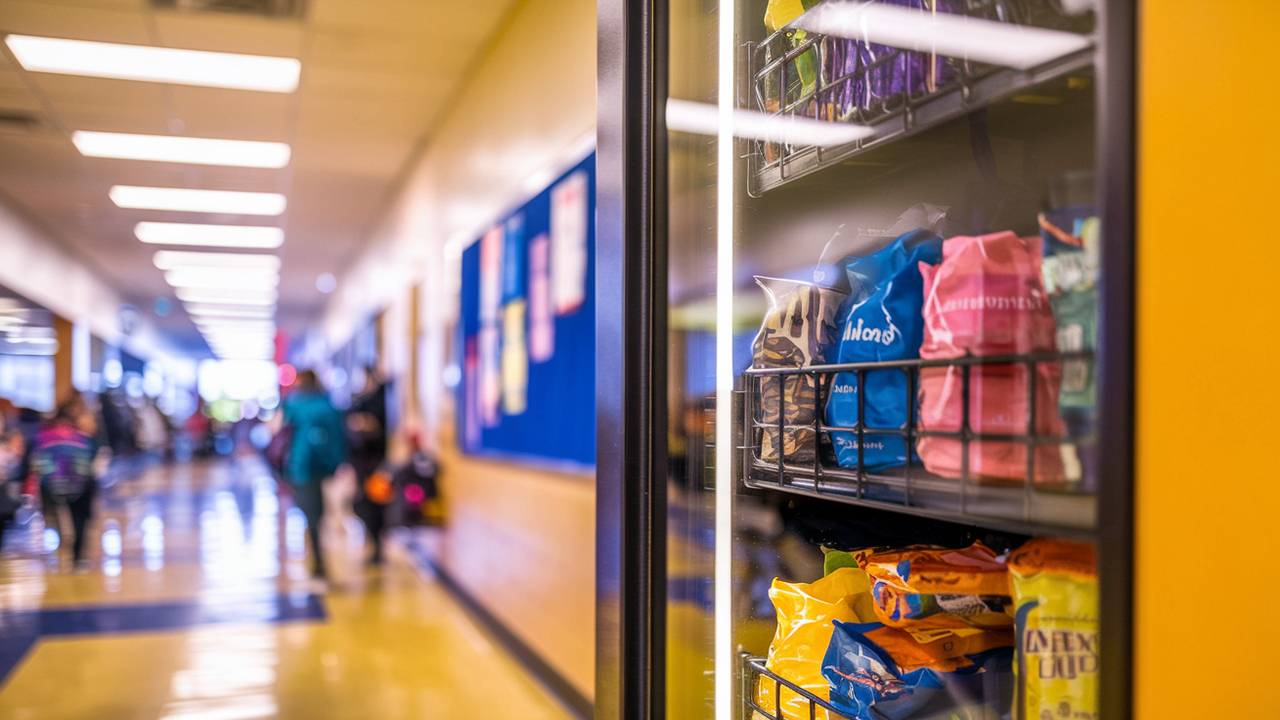What You Should Know Before Placing a Vending Machine in a School
Thinking about putting a vending machine in a school? Here’s what I’ve learned about school vending regulations, product selection, permissions, and what actually sells in a school environment.
Placing a vending machine in a school might seem like a goldmine — and in many cases, it is. But there’s a lot you need to know before rolling your machine into a cafeteria or hallway. From nutritional guidelines to school policies and student behavior, there are some unique challenges to keep in mind.
In this post, I’ll share everything I’ve learned about school vending machines, including what sells best, what to avoid, and how to get your machine approved without running into roadblocks.

Table of Contents
1. Understand Federal and State Guidelines
Before you do anything else, make sure you understand the Smart Snacks in School standards. These are federal guidelines that apply to any school participating in the National School Lunch Program.
That means your machine will likely need to:
- Offer snacks under 200 calories per item
- Limit sugar and sodium
- Include whole grains, fruits, or dairy options
If you ignore these rules, your machine might be removed quickly — and you could burn bridges with the school administration.
2. Always Get Written Permission
I never place a machine in a school without written approval. This usually comes from:
- The principal
- The district’s facilities manager
- Or a school board representative
Bring a one-page proposal outlining your machine’s dimensions, power requirements, refill schedule, and the types of products you plan to sell. This shows professionalism and builds trust.
3. Choose the Right Location Inside the School
Not every school area is ideal. I’ve had the most success placing machines in:
- Teacher lounges
- Staff break rooms
- Outside the cafeteria (with permission)
- School gyms or sports complexes
You’ll want to avoid placing machines near classrooms unless explicitly approved — noise and foot traffic can be disruptive.
4. Offer School-Friendly Products
Here are the types of school-approved vending snacks that sell well and meet most Smart Snack guidelines:
- Granola bars
- 100% fruit juice boxes
- Low-fat popcorn
- Baked chips
- Trail mix with no candy
- Dried fruit packs
- Plain or lightly flavored water
➡️ Shop school-friendly snacks on Amazon
Avoid candy, soda, and overly processed items unless your machine is only for staff.
5. Expect Seasonal and Daily Sales Variations
Unlike a 24/7 gym or laundromat, a school operates on a strict schedule. Expect:
- Higher sales during lunch and after school
- Lower sales on weekends or holidays
- Spikes during sports events or test days
Make sure your restocking schedule matches the school calendar, and build a routine around it.
6. Prepare for Younger Users
If you’re placing your machine in a middle or elementary school, keep this in mind:
- Use large, easy-to-read labels
- Make sure your machine is lower in height
- Stock snacks that don’t require much cleanup
- Avoid glass bottles or anything that could break
You’re serving kids — simplicity and safety matter more than anything else.
7. Always Keep the Machine Clean and Stocked
The school staff (and sometimes parents) are watching. If your machine is dirty, out of order, or filled with expired snacks, you’ll lose that location fast. I do a weekly check-in and deep clean my school machines monthly.
8. Offer Touchless and Cashless Payment Options
Most kids don’t carry cash anymore. I’ve seen a 25–30% boost in sales after adding a tap-to-pay card reader. Some schools even allow students to use prepaid cards or digital lunch account balances if integrated properly.
9. Work With the PTA or School Fundraisers
One smart strategy I’ve used is offering a small commission to the school or PTA. It might be 10% of monthly profits — just enough to incentivize cooperation and keep everyone happy. Some schools will give you exclusive vending rights if you help support their programs.
10. Consider a Lockable or Remote-Controlled Machine
For schools with younger kids or strict access hours, I use machines that let me disable sales during certain times of day. Some smart vending machines even let you shut them down remotely when needed.
Final Thoughts
Placing a vending machine in a school can be a great move — but only if you approach it professionally. Follow the rules, work with the administration, and put the health of the students first. In return, you can create a reliable, long-term vending location that’s low-maintenance and high-value.
One thing I always keep in mind is that schools are high-visibility environments. That means your vending machine represents your brand. If it’s clean, well-stocked, and compliant with school standards, it builds trust — not just with staff, but with parents and students too.
Some schools prefer to stock machines with locally sourced or organic snacks, especially if they promote healthy eating initiatives. I’ve worked with vendors who provide organic granola bars and no-sugar-added juices just for school machines, and it’s helped me stand out during the approval process.
Another big lesson I learned was to keep detailed sales reports by day and product. When I shared monthly data with the school principal, it helped them see how the vending machine supported students — and it also made it easier to justify adding a second machine near the gym.
In private or charter schools, you might have a little more flexibility in terms of what you can sell. I’ve been allowed to stock higher-calorie snacks as long as the majority of the inventory met Smart Snack standards. Always ask — sometimes, there’s room to negotiate if you’re transparent.
If your vending machine is going into a high school, don’t underestimate how well energy drinks and protein snacks sell after sports practice. I’ve seen machines do double the revenue when they’re placed strategically near weight rooms or athletic entrances (and get approval for product types).
Some schools are open to seasonal promotions — like back-to-school bundles or exam-week “snack packs.” I’ve offered pre-packed bags with chips, water, and fruit snacks during testing weeks, and they sold out every time. Offering this kind of creative value can build strong relationships with school administrators.
If your machine uses a touchscreen display, you can even advertise school events or messages on it. I’ve offered this to one school at no charge, and they loved it. It gave my machine an edge over competitors, and it didn’t cost me anything to do it.
Having a service response plan is crucial. Schools don’t want broken or empty machines. I make sure someone (even if it’s just me) can respond within 24 hours. Reliability makes you look more professional and keeps your machine from being unplugged for being a “nuisance.”
Some vending operators overlook teacher-only machines, but those can be gold. Staff lounges tend to have consistent users who spend more per item, especially if you offer premium snacks, healthier drinks, and even coffee options.
Security is another factor I’ve had to consider. Machines placed near entrances or less-monitored hallways should be anchored or bolted down, and have reinforced locks. While theft is rare, prevention shows the school that you’re taking things seriously.
Always ask for feedback from students and staff. I’ve used quick QR surveys or asked teachers to collect informal suggestions. This helps me rotate inventory with more accuracy and keeps the product selection fresh and student-approved.
Finally, always go into the school placement process knowing that you’re a guest in their ecosystem. Be helpful, cooperative, and proactive in solving any small issues. In my experience, that attitude turns short-term vending opportunities into long-term contracts.

